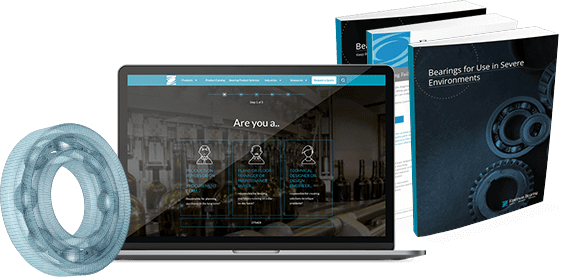The Art and Science of Precision Bearings
To the layman, a “Ball Bearing” may appear to be art, with the perfect symmetry of the shiny spheres retained by the flawlessly machined races.
To the engineer, however, Ball Bearings are a vital element in a system. Capable of supporting moderate to heavy radial and axial loads, these works of art are capable of operating at radial speeds of 400,000 RPM and higher.
To meet demanding application requirements precision ball bearings conform to ABEC-1 and ABEC-3 tolerances while high-precision ball bearings have to meet the tighter ABEC-5, ABEC-7, or ABEC-9 tolerances. Most general purpose ball and roller are in the ABEC 1-3 tolerance range and this is sufficient for 95% of all application. Super Precision bearings, ABEC 5-9, are used where there are higher demands in terms of axial and radial run out, limiting speed and dimensional tolerance.
Uses for precision bearings
Carrying a premium price, super precision bearings are carefully selected to optimise dimensional performance. The tight tolerances required in precision equipment would be unattainable without quality high precision bearings.
Typical applications include:
– Metal cutting and woodworking machinery spindles
– High speed turbochargers (Interestingly, manufacturers are beginning to turn to ceramics for diesel applications, because of the superior dimensional stability at elevated temperatures)
– Gyrostabilizers used in marine craft
– Vacuum pumps
– High speed rolling mills
– Printing machinery
– Precision ball screws
– Balancing machines
– Live centres
– In order to maintain these narrow tolerances during operation, it’s vital that the system operates in a contaminant-free environment.
Importance of cleanliness, and risks associated with particle contamination
The importance of clinical cleanliness when working with precision bearings is perfectly illustrated by looking at typical clearances and comparing this to common household “contaminants”:
For metric design ball bearings (miniature and instrument) with a bore diameter of less than 10 mm and a MC2 fit, the operating clearance is typically 0.0001 inches whereas a human hair is 0.003 inches.
The relative size (to clearance and lubricant film thickness) of the contaminants can cause severe damage by creating micro denting of the raceways and balls. This unintentional imperfection will manifest in accelerated wear, elevated temperatures, increased vibration and finally complete failure.
Correct Handling Of Precision Bearings
To avoid contamination and the resultant costly premature failure of a precision bearing it’s extremely important that the parts are handled correctly throughout the entire fitment process.

Take great care never to drop the part! The nemesis of any precision bearing is heavy shock (such as when the component is inadvertently dropped) during handling which can cause scratches, brinnelling, or even fine fractures.
Often overlooked during the handling of bearings is magnetization, which is often created by static build up. Although most quality bearings are demagnetized before shipment, induced magnetism during handling can attract particles, resulting in contamination.
The invisible destroyer of precision bearings is corrosion; either through corrosive gasses or more commonly through handling without protective gloves. Perspiration is highly corrosive and when coming into contact with the metal will result in corrosion which will initially be undetectable but will ultimately lead to wear. To avoid this, keep the bearings in their original wrapping until ready for fitment and always use the correct gloves when handling the parts.
Correct Mounting Of Precision Bearings
Before attempting to mount a precision bearing it’s important that the correct tools are available and that all equipment is burr-free and in good working order. Professional diagnostic equipment such as a bearing balancer and vibration analyzer are invaluable for the best fitment of these bearings.
When fitting a spindle bearing it’s important to use an induction heater to temporarily increase the clearance to facilitate fitment of the bearing to spindle. For small shaft/ small bore miniature and instrument bearings an arbour press will be sufficient.
Do’s and Don’ts
Following a few useful do’s and don’ts will make a significant difference to the performance and lifespan of the bearing:
– Keep the bearings in the original packaging until ready to install
– Only handle bearings with gloves
– When assembling the bearing to the shaft, first align the high point mark on the bearing ring 180o to the high point of the shaft
– Use an induction heater or arbour press (for interference fits) to facilitate assembly
– Use burr-free tools that are not plated, painted or contaminated by rust
– Use tweezers to handle miniature and instrument bearings
– Record bearing information contained on the packaging, and maintain updated logs
– Record mounting information for future reference
– Don’t wash new bearings
– Don’t wipe parts with a rag
– Don’t spin parts using compressed air
– Never apply shock loads to precision bearings
– Don’t use a hammer and screwdriver to install the bearing
– Never over-lubricate or mix classes of lubricant
– Don’t smoke, eat or drink while handling bearings
Using The Correct Grease
Grease is commonly used to lubricate precision bearings as this holds several advantages over other lubricants and lubrication systems:
– The bearings can be pre-lubricated
– The bearings can be lubricated for life
– There’s no need for the complexity of an external lubrication system
Because grease is fundamentally a lubricant (oil) with and added thickener, the compound used to thicken has a significant role to play in the performance of the grease.
The following compounds are typically used as thickeners:
– Sodium is a channelling thickener that is water soluble and good for speed ability up to 650,000dN
– Lithium is a soft (generally) non channelling thickener that is water resistant, with a speed ability up to 4,000,000dN
– Polyurea is a non channelling water resistant thickener that is rated at 400,000dN
– Clay is a water resistant non channelling thickener rated at up to 400,000dN
– Teflon is a water resistant, chemically inert non channelling thickener that has excellent thermal and oxidative stability
Recommended shaft and housing geometries
The correct shaft and housing geometries are fundamental in achieving long life and optimal bearing performance.
Critical in achieving the correct geometry are the bearing seats on the shaft and housing, which need to be accurately machined to match the bearing ring width, thereby maximizing the seating surface.
The shaft and housing shoulders must also be high enough to provide solid seating of the bearing, but not interfere with cages, shields or seals. The shoulders are also important for accurate alignment of the bearing whilst providing optimal support under maximum thrust load conditions
Learn more from Emerson
Emerson Bearing has decades of experience providing bearing solutions for a range of industries. To learn much more about the correct bearings for your application, contact us today.




















